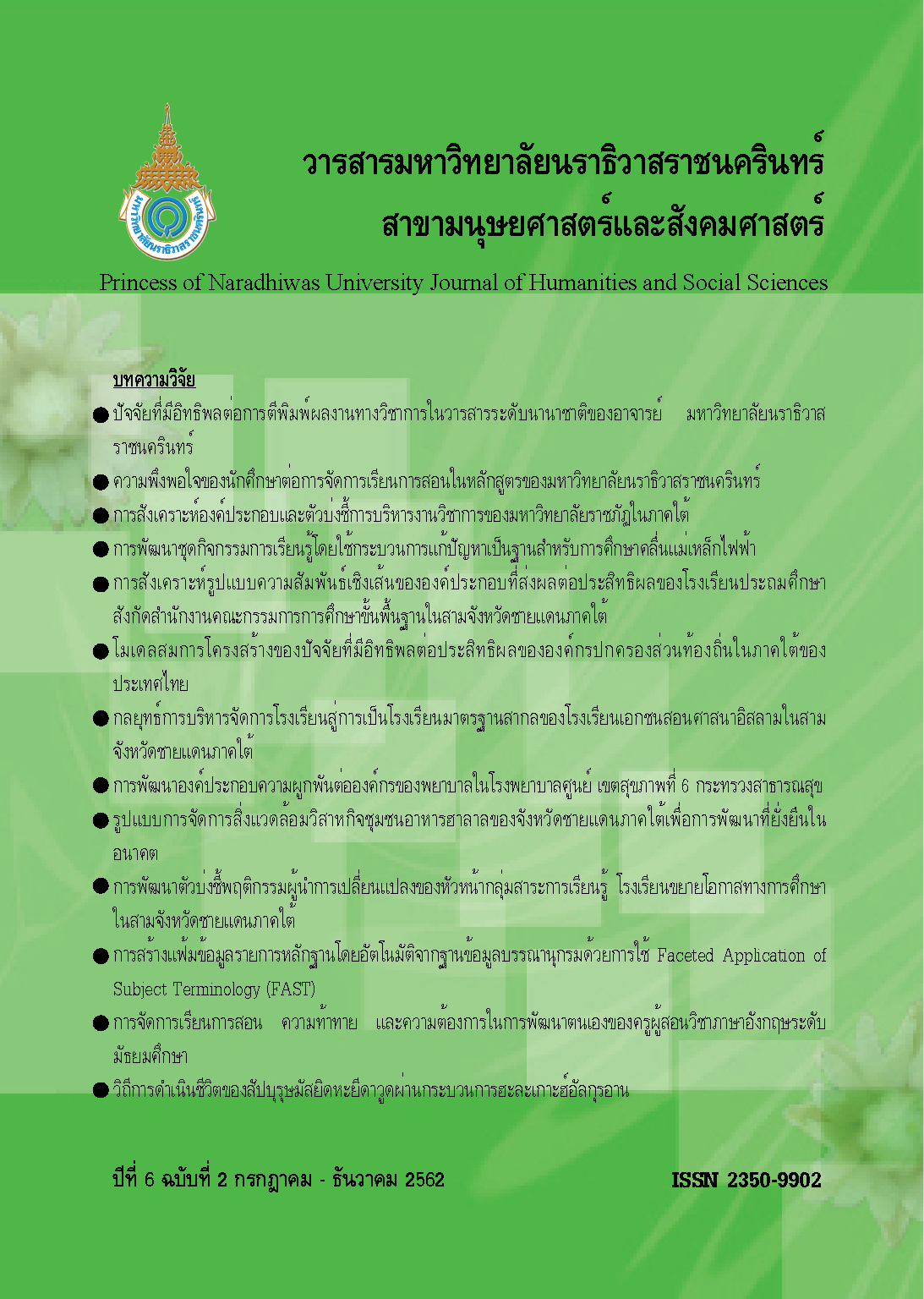The Factors Development of Nurse Engagement for Advance Level Hospital in Health Service Provider Area 6
Main Article Content
Abstract
The purposes of this research were 1) to study about main factors and sub-factors of employee engagement model, 2) to develop the indicators of being employee engagement of nurse, 3) to develop learning employee engagement of nurse model and 4) to evaluate consistency of developed employee engagement of nurse model by empirical data. The research consisted of four steps as (1) find the main factors, sub-factors and indicators of employee engagement, (2) confirm factors of employee engagement by facilitate a focus group and find validity and reliability by 30 experts, (3) find factors and indicators of employee engagement and (4) evaluate being employee engagement of nurse model. The sample consisted of 331 nurses from hospitals in health service provider area 6. Statistical analysis using Structural Equation Modeling by computer software.
The result of the study indicated that there were three factors as Behavioral Engagement, Affective Engagement and Continuance Engagement are important factors of employee engagement of nurse model for health service provider area 6 using Structural Equation Modeling. The result yield that the factor of employee engagement of nurse model is consistent with empirical data (Chi-square =23.68) and insignificant at .05 level (p-value =.20886). Relative Chi-square is 1.246, GFI is .98 and RMSEA is .027. Coefficients of all factors of employee engagement of nurse model are positive. All factors are significant at .01 level indicate that all indicators relate with the factors significantly. So, summarize is the model is highly consistent with empirical data. The result also yield that, in the employee engagement of nurse model for health service provider area 6, there are three main factors, nine sub-factors and forty indicators.
Article Details
References
กฤษดา แสวงดี.(2550). สถานการณ์กำลังคนพยาบาลวิชาชีพในประเทศไทย.วารสารวิจัยระบบสาธารณสุข, 2 (1), 41-42.
งานบริหารทรัพยากรบุคคล เขตสุขภาพที่ 6. (2560). สถานการณ์กำลังคนสายงานพยาบาลวิชาชีพ. สืบค้นเมื่อ 19 มกราคม 2560, จากhttp://region6.cbo.moph.go.th/chro/?page_id=225.
นภชา สิงห์วีรธรรม และยุพาวดี ขันทบัลลัง. (2560). สถานการณ์การผลิตกำลังคนด้านสุขภาพของสถาบันพระบรมราชชนกเพื่อตอบสนองความต้องการของระบบสุขภาพ. วารสารเครือข่ายวิทยาลัยพยาบาลและการสาธารณสุขภาคใต้, 4(3), 218-225.
นวัสนันท์ วงศ์ประสิทธิ์. (2558). ความผูกพันของพนักงานต่อองค์กร:ความท้าทายของการบริหารทรัพยากรมนุษย์ที่มีความหลากหลายของโรงพยาบาลเอกชนในประเทศไทย. วารสารการวิจัยเพื่อพัฒนาชุมชนมนุษยศาสตร์และสังคมศาสตร์, 8(1), 18- 34.
เนตรนภา นันทพรวิญญู. (2551). ความผูกพันต่อองค์การของพนักงานบริษัท เซ็นทรัล รีเทล คอร์ปอเรชั่น จํากัด. สารนิพนธ์ปริญญามหาบัณฑิต สาขาวิชาบริหารธุรกิจ มหาวิทยาลัยราชภัฏพระนคร. กรุงเทพฯ.
ภรณี มหานนท์. (2539). การประเมินประสิทธิผลขององค์การ. กรุงเทพมหานคร: สำนักพิมพ์โอเดียนสโตร์.
รินทร์ลภัส อรรถเธียรไชย. (2557). ความผูกพันต่อองค์การของบุคลากรสถาบันวิจัยวิทยาศาสตร์สาธารณสุข กรมวิทยาศาสตร์การแพทย์. ปริญญาวิทยาศาสตรมหาบัณฑิต (สาธารณสุขศาสตร์) สาขาวิชาเอกบริหารสาธารณสุข บัณฑิตวิทยาลัย มหาวิทยาลัยมหิดล.กรุงเทพฯ.
วิจิตร ศรีสุพรรณ และกฤษดา แสวงดี.(2555). ข้อเสนอเชิงนโยบายในการแก้ปัญหาการขาดแคลนพยาบาลวิชาชีพในประเทศไทย. วารสารสภาการพยาบาล, 27 (1),5, 9-11.
วรารักษ์ ลีเลิศพันธ์. (2557). ปัจจัยที่มีผลต่อระดับความผูกพันต่อองค์กรของพนักงานบริษัท เนชั่น บรอดแคสติ้ง คอร์ปอเรชั่น จำกัด(มหาชน). การค้นคว้าอิสระบริหารธุรกิจมหาบัณฑิต บัณฑิตศึกษา มหาวิทยาลัยเนชั่น, กรุงเทพฯ.
สำนักนโยบายและยุทธศาสตร์ สำนักงานปลัดกระทรวงสาธารณสุข กระทรวงสาธารณสุข. (2556). รายงานข้อมูลทรัพยากรสาธารณสุขประจำปี 2556. กรุงเทพฯ.
สุนาภา คุ้มชัย. (2552). ความผูกพันของบุคลากรต่อหน่วยงานราชการ: กรณีศึกษากรมชลประทาน. ปริญญาศิลปศาสตรมหาบัณฑิต สาขาวิชาการจัดการภาครัฐและภาคเอกชน. มหาวิทยาลัยศิลปากร. กรุงเทพฯ.
สุวิณี วิวัฒน์วานิช. (2554). การขาดแคลนพยาบาลกับการเป็นโรงพยาบาลดึงดูดใจ: ประเด็นท้าทายสำหรับผู้บริหารทางการพยาบาล. วารสารพยาบาลศาสตร์ จุฬาลงกรณ์มหาวิทยาลัย, 23 (1), 1.
อรุณรัตน์ คันธา. (2557). ผลกระทบและทางออกของการขาดแคลนกำลังคนทางการพยาบาลในประเทศไทย. วารสารพยาบาลศาสตร์, 32 (1), 84-86.
Allen, N. J. & Meyer J. P.. (1990). “The measurement and Antecedents of Affective, Continuance and Normative Commitment to the Organizational”. Journal of Occupational Psychology, 63, 1-18.
Cherrington, J.D.. (1994). Organization Behavior The Management of Individual and Organization Performance. Boston: Allyn and Bacon, 296.
Dunham, R.B., Gibe J.A. & Castanda M.B.. (1994). “Organization Commitment: The Utility of an Integrative Definetion”. Journal of Applied Psychology, 79 (June), 370.
Hewitt Associates. (2004). “Employee Engagement” [Online]. Retrieved January 19, 2017, from http://www.was4.hewitt.com.
Hrebinak, L.G. & Alutto, A.J. (1972). Personal and role – related factors in the Development of organizational commitment. Administrative Sciences Quarterly, 17.
International Survey Research. (2004). 3 D model employee engagement. Retrieved August, 2, 2015 from http://short.strange-company.info.
Kanter, R.M.. (1968). Commitment and Social Organization: A Study of Commitment Mechanisms in Utopian Communities. American Socilogical Review, 499 – 517.
Krejcie, R.V. & Morgan, D.W.. (1970). Educational and Psychological Measurment. New York: Minnisota University.
Luthans, F. (1994). Organization Behavior. (6th ed.). New Jersey: Mcgraw-Hill Inc, 124.
Mowday, Steer, R.M. & Porter, L.W.. (1979). “The Measurement of Organizational Commitment”. Journal of Vocational Behavior, 14, 2, 224-247.
Mueller, C.W. & Lawler, E.J. (1999). Commitment to nested organizational units: some basic principles and preliminary findings. Social Psychology Quarterly, 62, 325–346.
Spector, P.E. (1997). Job Satisfaction: Application, assessment, causes, and consequences. California Sage Publications, Inc.
Steers, R.M. (1977). “Antecedent and Out Comes of Organizational Commitment”. Administrative Science Quartery, 22, 46, 122-123.
Steers, R.M. & Porter L.W.. (1983). Motivation and Work Behavior. New York: Mc Graw-Hill Book Company, 303-304.


